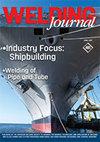板厚和接头几何形状对347H不锈钢焊缝残余应力的影响
IF 1.4
3区 材料科学
Q2 METALLURGY & METALLURGICAL ENGINEERING
引用次数: 0
摘要
在较高的使用温度下,347H不锈钢的焊接件可能容易发生应力松弛开裂。减轻多道次焊接中的应力松弛开裂敏感性需要对焊接实践和制造技术有很好的了解,以控制高拉伸残余应力。本文采用三维有限元模型,系统研究了347H不锈钢残余应力分布与基板厚度、接头几何设计和预热条件的关系。通过中子衍射测量值与计算出的弹性应变之间的良好一致性,对有限元模型进行了验证。在熔合区和热影响区(HAZ)内,有预热步骤和没有预热步骤的单v型坡口焊缝均产生相似的von Mises残余应力峰值,均大于450 MPa。在厚于0.5英寸的盘子里。(12.7 mm),从板厚中部到顶面下方,在相对较大的区域内观察到较高的拉伸残余应力。双v型坡口将高拉应力区转移到焊缝的中间厚度。单j型坡口焊缝能够将残余应力限制在熔合区内中厚附近很小的区域内,并将热影响区内的von Mises残余应力抑制在400 MPa以下。本文章由计算机程序翻译,如有差异,请以英文原文为准。
Impact of Plate Thickness and Joint Geometry on Residual Stresses in 347H Stainless Steel Welds
Weldments of 347H stainless steel are potentially susceptible to stress relaxation cracking at elevated service temperatures. Mitigation of stress relaxation cracking susceptibility within a multipass weld requires a good understanding of welding practices and manufacturing techniques to control high tensile residual stresses. In this work, the dependence of residual stress distribution in 347H stainless steel on base plate thickness, joint geometry design, and preheating condition was systematically investigated by using three-dimensional finite element models. The finite element models were validated through good agreement between neutron diffraction measurements and calculated elastic strains. The single-V-groove welds with and without a preheating step all produced similar peak von Mises residual stresses, above 450 MPa, within both the fusion zone and heat-affected zone (HAZ). In plates thicker than 0.5 in. (12.7 mm), high tensile residual stress could be observed in a relatively large area, from the middle of the plate thickness to underneath the top surface. A double-V groove shifted the high tensile stress area to the middle thickness of the weld. A single-J-groove weld was able to confine the residual stress to a very small region near the middle thickness within the fusion zone and suppressed the von Mises residual stress within the HAZ to below 400 MPa.
求助全文
通过发布文献求助,成功后即可免费获取论文全文。
去求助
来源期刊

Welding Journal
工程技术-冶金工程
CiteScore
3.00
自引率
0.00%
发文量
23
审稿时长
3 months
期刊介绍:
The Welding Journal has been published continually since 1922 — an unmatched link to all issues and advancements concerning metal fabrication and construction.
Each month the Welding Journal delivers news of the welding and metal fabricating industry. Stay informed on the latest products, trends, technology and events via in-depth articles, full-color photos and illustrations, and timely, cost-saving advice. Also featured are articles and supplements on related activities, such as testing and inspection, maintenance and repair, design, training, personal safety, and brazing and soldering.
 求助内容:
求助内容: 应助结果提醒方式:
应助结果提醒方式:


